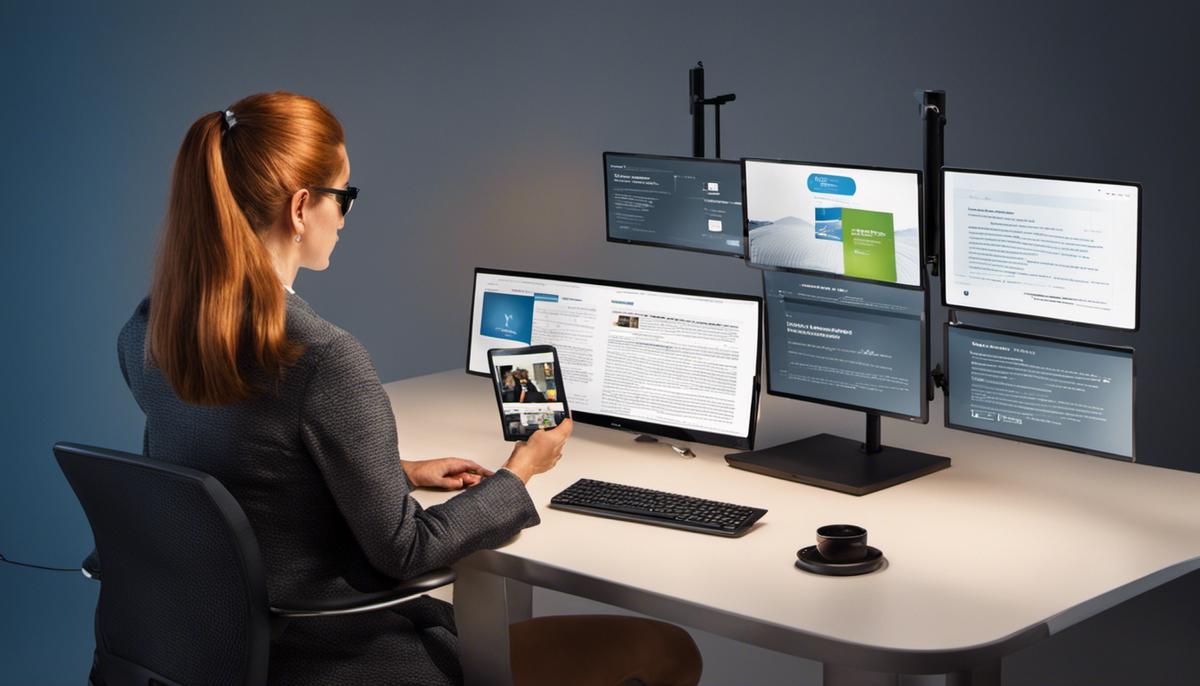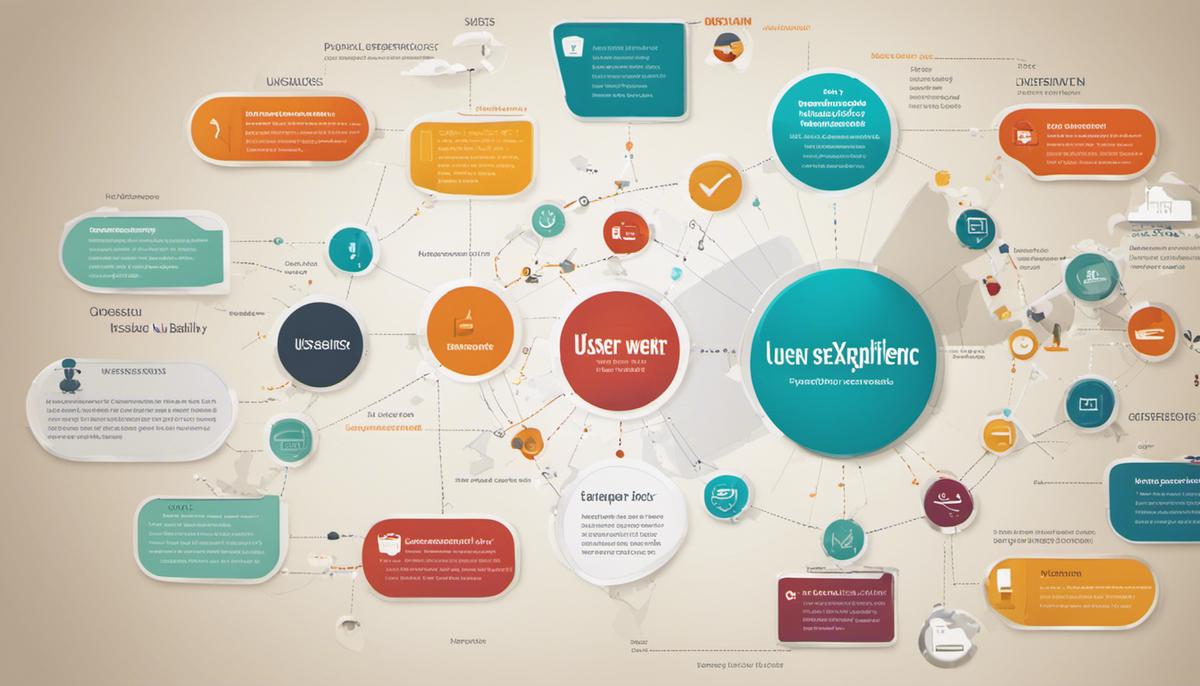The digital world stands as a testament to human advancement, continually transforming and expanding to cater to different user needs. However, for this advancement to be deemed as comprehensive, it must consider the diverse necessities of all users, including those with physical, visual, auditory, or cognitive challenges. In this regard, our focus lands on Web Content Accessibility – a principle aimed at making the web content perceivable, operable, understandable, and robust. As we delve into the web accessibility dynamics, we will highlight essential elements of accessibility guidelines, examine the technological aids improving web interaction for users with disabilities, and explore the challenges lying ahead for this significant cause.
Essentials of Web Content Accessibility
Unraveling the Core Principles of Web Content Accessibility
The web is the cornerstone of modern life today. It’s the global town square, the information superhighway – and becoming more indispensable with each passing day. However, it’s crucial to recognize that equal access to this resource isn’t always guaranteed. Web content accessibility is a pivotal factor in ensuring everyone, including people with disabilities, can fully engage with digital resources. Four fundamental principles guide these efforts: Perceivability, Operability, Understandability, and Robustness.
Perceivability, in a nutshell, is all about making sure that information isn’t invisible to all of a user’s senses. As technology aficionados, we must ensure that all users, regardless of their sensory abilities, are catered for. In practical terms, it includes offering alternatives for non-text content and providing options for users to see or hear content based on their sensory preference or abilities. Some examples include text alternatives for images (alt-text), closed captions for videos, and compatible design for screen readers.
Operability is next in line. Borrowing from the language of tech-speak, if a website isn’t built with optimal operability in mind, users are essentially dealing with a “system failure.” This principle dictates that users should have the ability to navigate and operate an interface comfortably, regardless of whether they’re using a mouse, voice commands, a keyboard, or a touchpad. It underscores the critical idea of designing and refreshing web content to be free of time constraints, avoiding content that triggers seizures, and providing easy navigation for users.
The principle of Understandability is just as it sounds. If users can’t comprehend the web content, the technology is working against, not for them. In essence, this principle revolves around making content readable and predictable in its behavior. Sticking to plain language, incorporating instructive text for form input, and sticking to consistent navigation are all strategies that come into play under this umbrella.
Lastl, but certainly not least, is Robustness. In our ever-evolving digital landscape, the ability for content to keep pace with technological advancements is essential. This principle emphasizes creating web content in such a way that it can consistently be interpreted by a wide array of devices, platforms, and assistive technologies. Why is this important? Keeping pace with new user agents, including assistive technologies, ensures everyone continues to have access no matter what new tech tools they’re using.
Understanding and observing these four principles – perceivability, operability, understandability, and robustness – is integral in moving toward a more inclusive web environment where everyone, regardless of ability, is able to access and utilize the resources freely. As tech enthusiasts with a love for problem-solving, it’s our responsibility to ensure advancement continues to be accessible advancement.

Technological Solutions for Web Accessibility
Forging ahead in the journey to create accessible web content, technology presents innovative solutions that are efficient, sustainable, and effective. At the crossroads of accessibility and technology, various pioneers are developing tools and platforms that not only enhance the digital experience for users with disabilities but also simplify the process for content creators.
One such tool is text-to-speech technology. This innovation breathes life into the written word, catering particularly to individuals with visual impairments or reading difficulties. A remarkable example in this regard is Google’s Read Along app, designed to assist children and adults with reading comprehension and pronunciation. The artificial intelligence embedded within these technological developments enables them to recognize and interpret written text and translate it verbally for the user.
Augmented and virtual reality technologies are also doing their part to enhance web content accessibility. Innovation in this sphere allows for multi-sensory experiences that cater to different user preferences and needs. For example, Facebook’s accessibility team is known for exploring the use of AR and VR to bring inclusivity to the internet, creating immersive and interactive experiences specially designed for individuals with various disabilities.
Another breakthrough comes in the form of accessible WordPress themes. Keeping the four core principles of web content accessibility in mind, these themes are designed to be perceivable, operable, understandable, and robust. The inclusion of features like color contrast tools, screen reader optimization, responsive designs, and SEO-friendly markup language allows web creators to build accessible websites right out of the box.
Machine learning and AI are also playing a pivotal role, analyzing websites to detect accessibility barriers. Machine learning algorithms can be trained to identify and correct issues such as missing alt text, problematic color contrasts, and coded elements that may be inaccessible to assistive technologies. Tools like AccessiBe make it possible to automatically scan and adjust websites for accessibility issues in real-time.
Customizable control settings for individual users are another tech innovation worth mentioning. Websites and applications that offer these features allow users to adjust the display and interactive elements according to their preference and requirements. Twitter, for example, has recently added the ability for users to increase the font size and adjust color contrast in its mobile app.
Looking forward, it’s clear that there’s an exciting future for the fusion of technology and accessibility. Innovations from augmented reality to machine learning are pushing boundaries, ensuring every web experience is open to all. If web designers, developers, and content creators stay committed to accessibility and retool their approach in tandem with new tech, a fully accessible internet might not be as far away as it seems.

Challenges and Future of Web Content Accessibility
As we progress further into the realm of digital dominance, breaking down barriers for people living with disabilities becomes an increasingly critical task. While strides have been made in web content accessibility, the journey is far from over. The challenges linked to web content accessibility primarily revolve around three areas: implementation, maintenance, and legislation updates.
Firstly, the technical challenges of implementing accessibility on a broad scale remain. Building an accessible website is not as simple as adding a plugin or a widget. It requires a deep understanding of W3C’s Web Content Accessibility Guidelines, web development, and user experience design. It’s not impossible, but it requires time, resources, and training, which can make it a daunting initiative for many organizations.
Next is the challenge of maintaining accessibility. Just as websites continually evolve with updates for better design or new content, it’s important that accessibility keeps pace. It’s not a one-time task but a continuous process that demands regular monitoring and testing. This can add a layer of complexity to even the most dedicated development teams.
Finally, comprehensive legislation surrounding digital accessibility remains patchy around the globe. Inconsistencies in laws among different countries lead to uncertain standards, making it challenging for global organizations to maintain accessibility uniformly across their platforms.
But amidst these challenges, technology is positioning itself to offer robust solutions.
To begin, promising advancements in Machine Learning (ML) and Artificial Intelligence (AI) indicate they might be game-changers in website accessibility. AI can learn to rectify many accessibility errors on its own, like image recognition technology adding alt-tags to images, thereby drastically reducing the manual tasks involved. Furthermore, ML can gather vast amounts of data, identify patterns, and predict user needs, potentially ushering in a future of automated and highly personalized accessibility solutions.
Next in line are technologies like Augmented Reality (AR) and Virtual Reality (VR). They hold promise for immersive experiences that transcend traditional boundaries. For instance, visual information could be transformed into spatial or auditory information, granting access to users with visual impairments.
And speaking about innovations, let’s not forget WordPress, which powers a significant chunk of the web. The platform is making accessibility easier with the wide array of accessibility-ready themes it offers, allowing thousands of websites to be more inclusive.
Further strides include Text-to-Speech technology. It’s not new, but improvements have made it an increasingly viable tool for persons with various disabilities. Then there’s the move towards customizable control settings for users, which hand the reins of accessibility back to the users themselves, allowing them to shape their digital experience according to their individual needs.
While the challenges associated with web content accessibility are significant, so too is the potential for technology to dismantle these barriers. With continuously evolving technology and an ever-increasing understanding of diverse user needs, the prospect of accessibility for all could be much closer than we think, painting an optimistic picture that the future of web accessibility is poised for groundbreaking evolution.
One thing is clear: In the quest to honor the principle of access for all, there’s no room for complacency. As technology enthusiasts geeking out over the latest trends, it’s up to us to champion this cause and ensure that technology serves everyone, not just a few. Embracing the challenge of accessibility is not just a legal requirement but an ethical and social one, and meeting that challenge could lead to an exciting synthesis of technology and inclusivity.

Web Content Accessibility is not a benefit exclusive to users with disabilities; it represents a conscientious push towards equality in the sphere of information and knowledge. As we advocate for and implement these practices, we stand to enhance the internet experience for all users while combating digital segregation. In the whirlwind of advancements, however, it’s crucial to retain awareness and navigate the challenges of anchoring heavily on technology for access. As the digital future unfurls—with the Internet of Things (IoT), Augmented Reality (AR), and further innovations—it holds enormous potential to reshape the landscape of web accessibility. With vigilance and adaptation, we can forge a digital world barrier-free, facilitating the journey of every user across the worldwide web.






